A kite balloon combines a lifting gas with active lift structures like wings to fly in all conditions. A good design may solve the common difficulty of flying in light winds, which makes balloon mapping difficult, but still falls short of kite-flying weather. It may also help reduce helium use, and therefore price.
Developments thus far:
Materials:
While many balloon mappers use rubber or latex balloons, we've found that they deflate after only a few hours, and cannot be used more than a few times before becoming too worn and delicate. We're experimenting with Mylar (boPET film) and EVOH (Ethylene Vinyl Alcohol) with now because they are gas barriers, unlike Polyethylene (HDPE/LDPE/LLDPE) -- meaning that, once inflated, such balloons can stay inflated for days or even weeks. Like polyethylene, EVOH can be heat-seamed with a soldering iron or plastic bag sealer. Mylar must be glued.
EVOH available for sale at balloonkits.com, Heat Seaming Tutorial
Mylar should be glued with UHU Power Stic in lap joints according to forum discussion on RC Groups. UHU Power Stic doesn't appear to be for sale in the USA, but can be found on Ebay UK.
Tests
Tests are occurring on configurations of mylar sleeping bags at the Gowanus Canal site in January 2011:
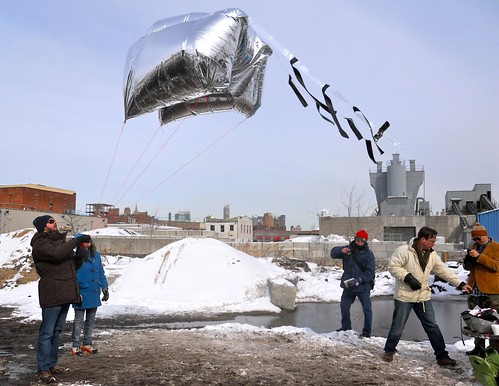
A successful flight mapping based on Leif's and Liz Barry's design. Notes from flight?
Another mylar sleeping bag kite in Lima PeruJanuary 2011:

This kite was lost, pulled off its line by wind. Questions: is this the appropriate balance of active and passive lift?
Another one in Peru. This kite-balloon needed a second mylar sleeping bag to lift the camera, ruining the aerodynamics. The horizontal sleeping bag doesn't work well.
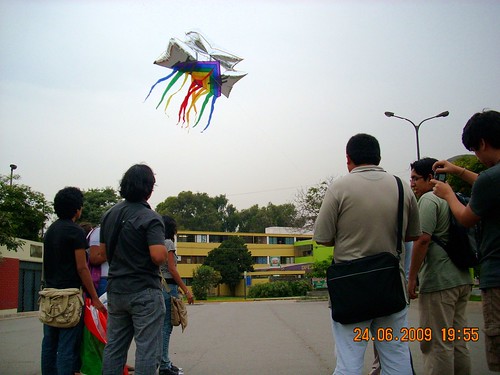
The Black Knight, by Jeffrey Warren, Oliver Yeh, and Reid Beels, April 2010
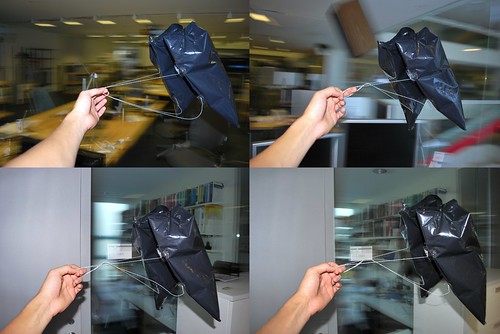
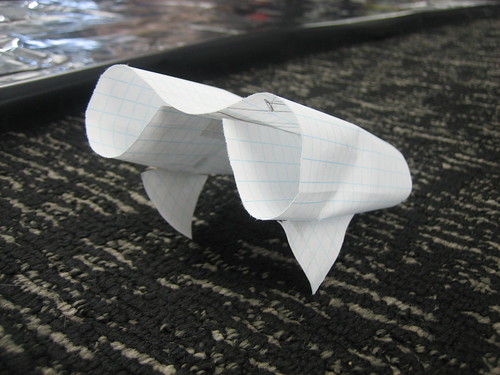
This kite had structural problems in its construction and broke quickly. It is an attempt at a helium sled kite. Other problems: material- it was made from polyethylene, which is not a gas barrier. Otherwise, a fine early flight and prototype.
A blimp-style kite balloon from Grassroots Mapping's NuVu Studio workshop April, 2010:

This balloon was also lost, owing to a knot. Problems: Balloon does not hold its shape in pressure due to dispersion and lack of rigid structures. Material is polyethylene, which does not retain helium well.
(/place/new-york-city)
Mathew Lippincott-I built several kite balloon models in July of 2008. I didn't have a digital camera at the time, so I don't have many flight photos. My conclusion was I needed to learn more about plastic and seaming before attempting to fly one of these designs.
This ribbed balloon with internal supports seemed to fly reasonably in medium winds when inflated with air and with a tissue paper tail attached. The internal supports were taped and the envelope heat seamed, but small tears developed around the internal supports during flight. Built from .315mil HDPE.
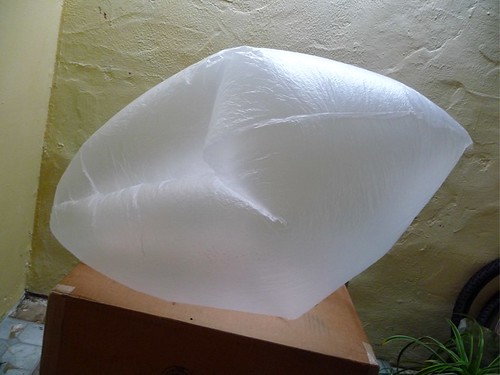
Earlier, I'd built a lenticular kite balloon with inflatable fins. This was before I'd found the Helikite design, whose rigid structure is far superior. I taped it together. oops! full of holes.
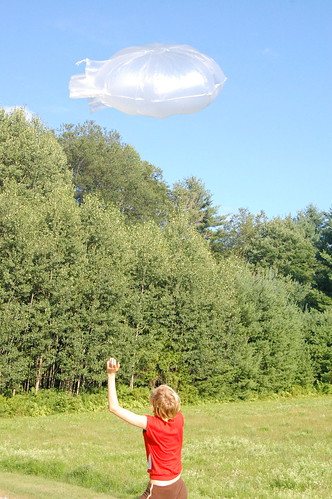
Inspiring Shapes
Sled Kites

Sled kites with balloon re-enforcements on the sides inspired Jeffery and Leif's designs. They have a high active lift (wing lift) to static lift (gas lift) ratio. Helium here is a means of lifting a kite into higher winds at higher altitude. More ram/sled kites here.
This technology was invented by Domina Jalbert, who also experimented with kite balloons in the 1940's, and later invented the rammed air air foil. Ram-air structures also appear on the early Parseval-Sigsfeld balloon.
Lifting Bodies
Lifting bodies are high-volume shapes that produce active lift like wings do. They would be good compromise shapes for a kite balloon, allowing a high volume of lifting gas and aerodynamic stability

Examples of kites using lifting bodies can be seen in lenticular kite balloon designs, like the commercial Southern Balloon Works Kingfisher and Allsopp Helikite.
Bowed Kites
Traditional Asian bowed kites are very stable. They are also curved like the underside of a balloon. Features of Bowed kites can be seen in the Allsopp Helikite, detailed below under "Alternatives to the blimp shape."
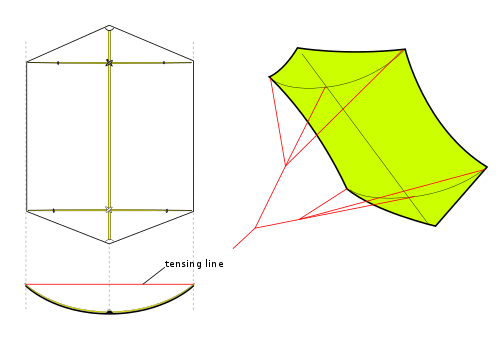
construction and commercial manufacturing
Mathew- I went to my local party store and looked for construction methods amenable to a kite balloon design. This turtle was the only balloon I found with a pattern of more than two gores (it has three. The turtle's main body is less wrinkled than circular party balloons, has a high volume for its size, and a flat bottom that looks like it could kite. it will probably be cheap to mass produce: it is made in a single motion out of a folded sheet of plastic, as detailed in this endearing 1927 patent for a more realistic inflatable elephant.
I flew it as a kite, giving it two tails. I couldn't get the balloon to balance right owing to the weight of the head and flippers, so and the tool balloon nose dives in the wind. A larger balloon with more helium would allow more thorough testing.

Patents
History of Kite Balloon Designs
Early kite balloons were used for artillery observation, and had to be manned. Large balloons have different design constraints, but similar functions to small kite balloons. From discussions with users of contemporary small kite balloons, it appears that these cigar, sausage, or "blimp" style balloons (sometimes called photoblimps) aren't particularly stable below 15ft long. That said, early designs show the basics of kite balloon structure, strategies to maintain rigidity, and rigging concepts that we can probably learn from. In terms of shapes to pursue in development, see "Alternatives to the blimp shape" below and "Inspirations" above.
Large Kite Balloons 1896-Present
Designed during 1895 and 1896, the Parseval-Sigsfeld kite ballon (Drachenballoon, or colloquially, "sausage balloon") was the first observational balloon integrated into regular military field service. Its ability to climb into the wind and maintain its shape were due to a balloonet (listed as a diaphragm in the illustration) in the back that was inflated by a wind rushing into duct underneath, similar to the structural members of a rammed air sled kite. here is a diagram of the Parseval-Sigsfeld balloon:

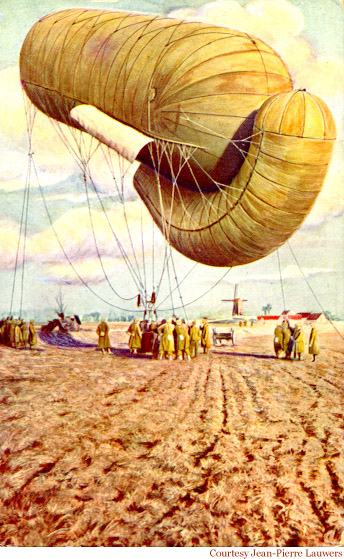
Early experimental versions had a drag sail on the back instead of a duct. This same means of stabilization is used in the contemporary Southern Balloon Works "Kingfisher". Here is a terribly low-res image of an early experimental Parseval-Sigsfeld design:
Parseval-Sigsfeld style balloons first saw battle during the Russo-Japanese War (1903-1905), and were notably well integrated with mobile artillery by the Belgians during 1914's German invasion.
During World War I, the Parseval-Sigsfeld was replaced by the more Caquot-type balloon which looks more like a blimp, and whose design continued to evolve into the the streamlined balloons still used today for radar domes. Later Caquot-style models used a fan to forcibly pressurize their balloonet.

This is "Fat Albert" a broadcast tower and radar dome used to watch Cuban airspace from the Florida Keys:

The balloonet & duct system is also used to control lift and rigidity in blimps. This diagram of the Goodyear Blimp accurately represents how the balloonets work on simpler kite balloons:
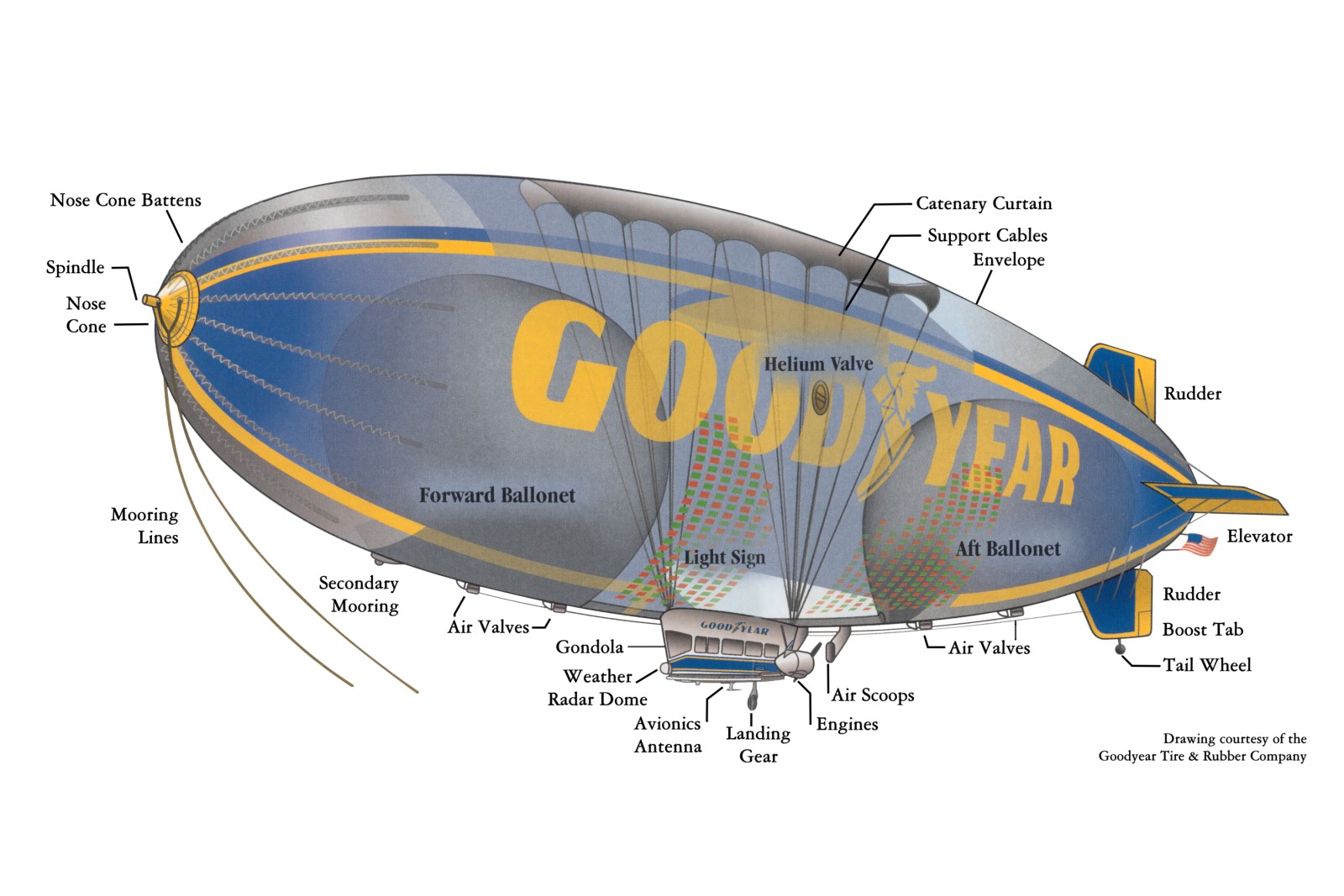
Small Kite Balloons: 1940's to present
Amateur Radio Operators began looking for a good way to put up antennas, renewing interest in kite balloon development. Domina Jalbert Patented a kite balloon in the mid-1940's, and his design is similar to the "blimp" style Caquot balloons. His patent describes the design rather well. Jalbert used pressure and rigid structures only to maintain his kite balloon's shape, rather than rammed air ducting. All the small kite balloons I've seen do the same.

Contemporary Plastic Caquot Style balloon, often sold as "photo blimps." I'm not sure what brand this is:

Alternatives to the Blimp Shape
Recently, lenticular (lens-shaped) kite balloons have emerged. From discussions with users of "photo blimps", I (mathew) have heard that at below 10-15 feet long the design is not particularly stable. The lenticular shape appears to be more stable, and it aught to be more space-efficient, having a higher volume than the blimp shape. Lenticular objects are a form of lifting body (see "Inspirations" below) and may perform as active (wing-like) lift structures.
The Helikite, manufactured by Allsopp in the UK, apparently flies in up to 40 knot winds, and yet is only 6 ft long.
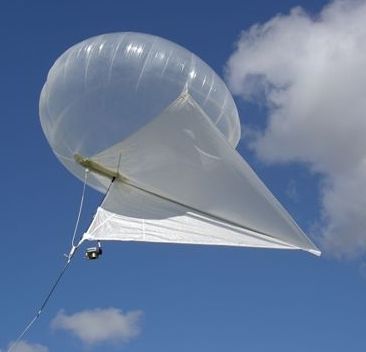
It is notable that as well as being lenticular, the Helikite's wing structure shares features with the Japanese Rokkaku, or bowed kite (see "Inspirations" below)
Southern Balloon Works manufactures a kite balloon called the Kingfisher that is lenticular, but uses a sail in the back for stability, like the early 1895 experimental Parseval-Sigsfeld balloon. This is curious, why use a stability strategy 115 years out of date? One of the GRM participants has used the kingfisher and says it's kind of a pain. (CITE)
The Southern Balloon Work Kingfisher:


.jpg)
No comments:
Post a Comment